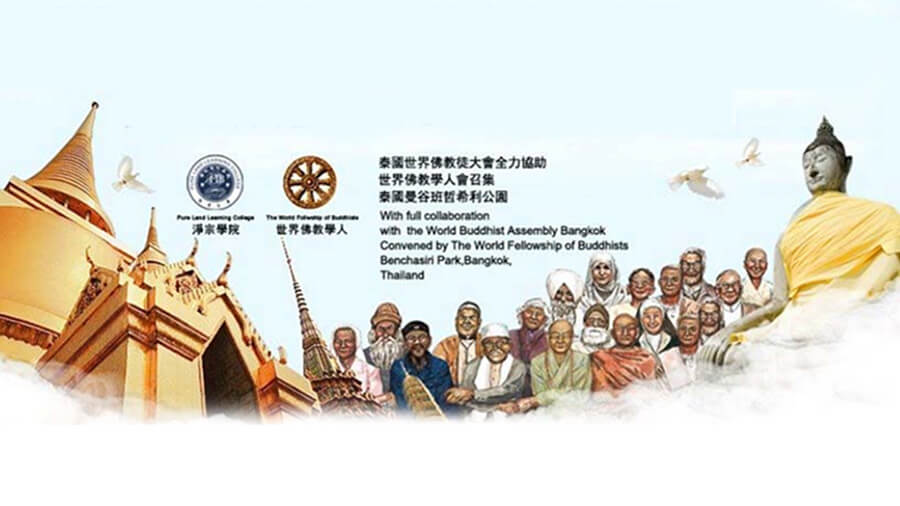The Pursuit of Peace
2012 Multi-Faith Summit Theme
2012 has been an unusual year. It is not only the year for the realization of the planet-wide catastrophe predicted by Mayan prophecy, but also the year of the 2600th anniversary of Buddha Shakyamuni’s enlightenment. For Thailand, it is the year of His Majesty King Bhumibol Adulyadej’s eighty-fifth birthday, Her Majesty Queen Consort Sirikit’s eightieth birthday, and His Majesty Prince Maha Vajiralongkorn’s sixtieth birthday. It has been a very gratifying year for Thailand’s royal family.
Therefore, the World Fellowship of Buddhists and the Pure Land Learning College Association Inc.co-hosted a multi-faith summit in Bangkok with the theme of “Achieving World Peace through Religious Harmony and Conflict Resolution. ”Although we are of different ethnicities and have broad cultural differences, we have the same wish that all countries become prosperous and their people live in peace; that all countries peacefully coexistent and become mutually prosperous; and that international communities achieve enduring peace.
What caused people to become very anxious is that although they have wonderful expectations, they saw that the world has been experiencing natural and man-made disasters. As the only founding nation of Buddhism, Thailand has profoundly realized that as its foremost responsibility and obligation, it must dedicate itself to the restoration of world peace. As one of the first founding Buddhist universities in Australia, the Pure Land Learning College Association Inc. shoulders the burden of the ancient precept that says, “Everybody is responsible for the rise and fall of a country.” Over the past decade, the college has dedicated itself to reconciling conflicts and harmonizing different religions. Therefore, the World Fellowship of Buddhist, headquartered in Bangkok, co-hosted the summit along with the Pure Land Learning College Association Inc., in order to come together to discuss how to achieve world peace.

Starting from 21 May 2012, five hundred religious leaders from around the world, representing ten religions, gathered together in Bangkok. While they dressed differently and spoke different languages, they all shared a common goal – to achieve“religious harmony” and that“all religions are one family.” The ten religions represented were: Baha’i, Buddhism, Christianity, Jainism, Hinduism, Islam, Judaism, Sikhism, Taoism and Zoroastrian.
When the five-day forum came to an end, participants had again witnessed that all religions teach the education of love and peace; only the education of love can bring about happiness and only the education of peace can harmonize all ethnicities of the world. The true meaning of religion had been expressed again; the essence of religion is education, it is primary education, an important teaching that is worthy of our veneration.
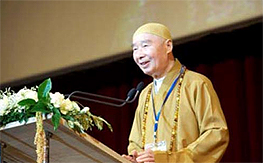
Highlights of Venerable Master Chin Kung’s Speech
• Buddhism has a long history. It is a perfect teaching of the utmost virtuousness taught by the Buddha for the benefit of all beings in the Nine Dharma Realms. Learning Buddhism is the ultimate enjoyment of life.
• During his life-time, the Buddha was a voluntary social educator who taught for forty-nine years. The Buddhist Sutras are all inclusive. They are far more perfect than today’s university education.
• Physicists who study quantum mechanics have recently proven that Buddhism is not only the pinnacle of all philosophies in the world, but also the pinnacle of science in the world. We are persuaded by the joint confirmation between Buddhism and state-of-the art science that Buddhism is a perfect teaching of the utmost virtuousness.
• Only when Buddhist teachings are practiced in daily life and one is a sincere student, can they receive real benefit. One can then help others.
• Owing to the crisis of natural and man-made disasters in recent years, people have realized that there is a great need for restoring the teachings of saints and sages. People will be convinced of the benefit of ancient saints and sages’ education by building a model site of harmony using the teachings of saints and sages. Saints and sages’ education is the only way to reconcile conflicts and achieve enduring world peace.
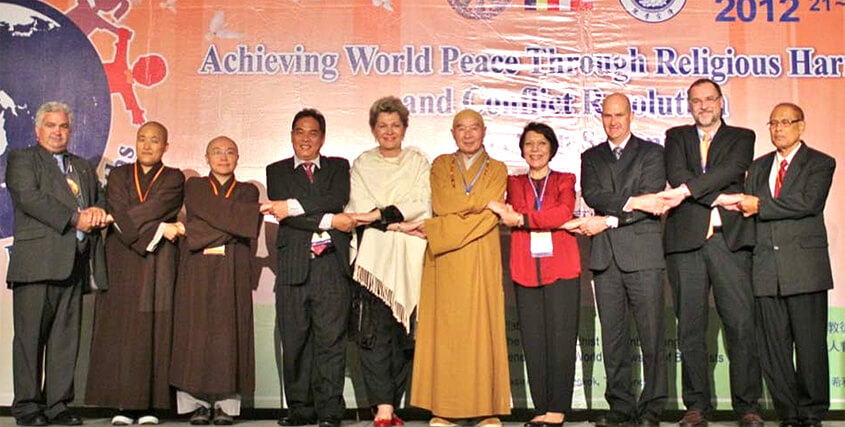
Religious leaders and Her Excellency Ms Katalin Bogyay, Hungary’s Ambassador to UNESCO and President of the General Conference of UNESCO, holding hands, symbolizing world peace.
Religious Education – Ways to Achieve World Peace
On 23-25 May 2012, at the Imperial Queen’s Park Hotel, religious leaders from ten different religions participated in round-table discussions, explored the relationship between religious harmony and world peace, and discovered ways to achieve world peace. During the meeting, Venerable Master Chin Kung delivered a keynote speech titled “Eliminating Crises through Religious Education,” where he appealed for the restoration of religious education and how that will be the only way to reconcile the crises that the world is now confronting.
The summit provided all religious leaders with sufficient opportunities to discuss religious harmony, concrete strategies, and feasible solutions for restoring the true nature of religious education. The group meetings discussed and shared the experiences of religious education, the issues of inheriting traditional morality and virtues, how to enhance the dialogue of different religions from different cultural backgrounds, and how to ensure that the interaction and cooperation of multi-faith is feasible. The discussions of these topics were offered by Her Excellancy Ms Katalin Bogyay, Hungary’s Ambassador to UNESCO and President of the General Conference of UNESCO. She realized that what the multi-faith forum was trying to achieve was the same as the United Nations, even though they have different approaches. She stated that the United Nations supports multi-faith and multicultural activities that seek peace and happiness for humanity.
The last day of the summit focused on discussions of reconciling conflicts, promoting religious education, cooperation of different religions, and so forth. All the participants had not only reached a consensus on the restoration of religious education, but also considered the establishment of their own model city of religious education as an imperative. They had also realized that it was the most effective way to achieve enduring world peace. Mr. Russi Giadiali,an elder of Zorastrianism, called on all religious leaders to put their words into action, i.e. to establish a model city of their own religions, at once.
Keynote Speech by Venerable Master Chin Kung
Eliminating Crises through Religious Education (Excerpt Highlights)
23rd May 2012 10:30-12:00
• How I started learning Buddhism.
I loved reading when I was young. Even when I was deprived of schooling, I never stopped reading. I had the opportunity to learn about Buddhist Philosophy when I was twenty-six years old. My teacher taught me that Buddhism was not found in temples, but in the Sutras.
• The confidence of ancient saints and sages is derived from their respectful attitude. One can receive real benefit if they study the saints and sages’ teachings with sincerity and respect, and without doubts.
• Buddhism is not a religion.
Each religion has a God. The Buddha is an awakened person. Everybody can achieve enlightenment and become a Buddha. Buddhism attaches great importance to wisdom rather than to knowledge. One with wisdom will understand all knowledge naturally. As long as one does not give rise to thoughts and lets go of afflictions and attachments, they will understand all. Buddha Shakyamuni is a good example.He left home at nineteen years of age, studied for twelve years and achieved enlightenment when he was thirty.
• Buddhism embodies profound science and philosophy
The newest research report on quantum mechanics has helped us break from doubts completely. Matter originates from consciousness. “All phenomena are manifested by the mind and altered by the consciousness.”I believe that Buddhism will be classified as the most advanced science and philosophy in the next two or three decades.
• The root causes of today’s social problems The root causes of today’s social problems are the problems of education. People who are religious are fewer and fewer. Religious education must be restored. Looking back on religious history, the founders of each religion were educators.
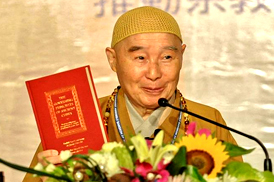
• Practice validates the truth Any experience without verification is not a good experience. We will promote religious education and influence the rest of the world by setting up a “Multicultural Model City of Harmony” in Toowoomba, Australia.
The Chinese classic, Imperial Compilation of Books on the Principles of Governing, has provided essential governing wisdoms. We are planning to translate this set of books into English; one book per year; ten years to finish. I wish these virtues will bring the world enduring peace.

Putting Words into Action
25 May 2012 Summit Discussion Minutes
Many representatives were concerned about what actions they should take after summit. Issues raised include: How to ensure the cooperation between religions is feasible and how to draw the attention of government officials to religious dialogues and participation in a summit like this one?
Attendees pointed out that the current practice has proven that religious cooperation does, in fact, not only accord with the interest of administrative rulers, but also provides a stable communication platform. Such practice proves that politicians can gain more all-round information through religious dialogues. All religions should do their utmost to promote the experiences of religious harmony in Australia back in their own countries.
Furthermore, a number of religions could jointly establish a coordinating organization. There are already precedents. In countries such as Malaysia, which has many different religions, five religions jointly established a coordinating committee that harmonizes religious issues in their country. People are gratified by the success achieved. Religions that are members of the committee enhanced their mutual understanding by working together. They have been united as one for many years. This is a very effective experience.
The Key to Saving the Religious Education Crisis is Faith and Action
Closing Speech by Venerable Master Chin Kung
(Audio Transcription) 25 May 2012
Today’s world has witnessed an increase in the occurrence of uncertainty, instability, and natural and man-made disasters year by year. To reconcile disasters and help society towards harmony is something that everyone wishes for from the bottom of their hearts. Many people have lost faith in peace. We sustain our faith with great difficulty. We in fact understand the principles and methods, but how to put them into practice is a serious question
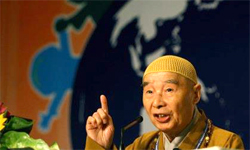
In previous years, we participated in many conferences that were convened by the United Nations Educational, Scientific and Cultural Organization (UNESCO). We presented the ideas of ancient saints and sages to the attendees.
Everyone was pleased with the ideas. However, after the conference, some people told me that those ideals were not feasible. Therefore, how to help people gain confidence is a major issue. People only believe what they see.
In 2005, the experiment at Tangchi achieved good results within only four months’ time that initially was anticipated to take two to three years. We couldn’t even believe it ourselves. We were very cheerful with the results. This experiment had demonstrated that human nature is originally good. It has also demonstrated what the Buddha said in the Mahayana Buddhist sutras that “All sentient beings are originally Buddha.” Simultaneously, it proved that “People can be taught to be good”. But the problem is who is going to teach?
After its establishment, I said to the teachers in Tangchi center that the most successful educators were Buddha Shakyamuni and Confucius. But why were they successful? The reason was that they practiced what they taught. If one has not practiced, one is not qualified to teach. One can only teach when they have practiced.
Confucius had practiced the Five Human Relationships, Five Moral Principles, Four Social Bonds and the Eight Virtues. Buddha Shakyamuni had practiced the Three Refuges, Five Precepts, Six Paramitas, Ten Virtuous Deeds, and the Ten Vows of Samantabhadra Bodhisattva. They then started teaching people. People could thus believe them. For teaching to be effective, one must first practice. Then one can become a saint. If one could put into practice what one teaches, one would be a sage. If one couldn’t practice what one teaches, but hoped others were able to, one would be a liar. I used these words to encourage teachers and to emphasize to truly practice ourselves.
Where should we begin? We should begin with the Standards for Being a Good Student and Child and integrate it with Taoism’s Accounts of Request and Response and the Ten Virtuous Conducts. To practice what we learn, to set a good example. I asked the teachers to achieve this within four months’ time; they listened to my words and actually achieved it within two months. I was very much moved! Afterwards, they travelled to rural areas, gave lessons to villagers and practiced filial piety to each family. When they saw the elderly, they treated them as their own parents and as if they were their children. When they returned from work, their attitudes toward the elderly were just like their attitudes towards their own parents. Many people were profoundly moved. The elderly felt that they didn’t teach their own children properly when they witnessed these teachers’ behaviors and wanted to learn from these teachers. Meanwhile, the younger people felt ashamed when they saw how respectful and careful these teachers were towards their parents.
Therefore, we didn’t teach using words, but by actions. We did this for three weeks. We then told the public that our center would begin offering lessons and welcomed everyone to join. We didn’t enroll students, but many people joined. We brought a great change to this town of 48,000 people by significantly restoring their good social values. They became unwilling to commit wrongdoings. They felt it was wrong to have evil thoughts.
A taxi driver found a customer’s briefcase with more than seventy thousand RMB and returned it to the owner immediately. The owner was very happy, saying: “There are still such people in this place.” The owner wanted to reward the driver with twenty thousand RMB. But the driver refused saying that was what he should have done. He said to the owner: “We received the teachings of saints and sages. We thus know how to behave as a human being. Beforehand, I might not have returned it to you. And I would like you to know that I am not the only person who would have returned it to you, because if it had happened to other drivers in Tangchi, they would have all done the same.” Such great outcomes made us truly have faith in traditional Chinese culture.
With the success of the Tangchi experiment, we firmly believe that the teachings of saints and sages can save society, change the general mood, reconcile conflicts, and advance the stability of society and world peace. This is true, not false! But to introduce this experience to UNESCO and the whole world is not an easy task. But we have a strong aspiration! What we could never imagine happened after two months: UNESCO invited me to attend a conference in October, 2010. The conference was to commemorate the 2550th anniversary of Buddha Shakyamuni’s enlightenment with the theme of “Buddhist Contributions to Humanity.”
It was because UNESCO contacted Thailand first and the Thailand Ambassador recommended me. We therefore launched a four day event. This was due to the Buddha’s blessings and our ancestors’ virtues.
The successful experiment at Tangchi told us two things: “People can be taught to be good.” and “Religions can be united.” I therefore invited nine religions from Singapore and Australia, respectively, to conduct a joint prayer for world peace. We also presented the achievements of this project for eight hours at UNESCO. 192 representatives from different countries pledged to visit Tangchi. The local government also considered that it would be a good thing. However, they also felt it would not be possible for them to receive so many visitors. Eventually, the plan was cancelled. However, there were still some representatives who visited Tangchi as tourists and stayed there for a few days witnessing its success. We therefore are more confident. We must set a good example.
Over 3800 years ago, Chinese Emperor Tang of the Shang dynasty, set a good example for all. China was not unified at that time. Each tribe governed a small territory. According to historical records, Emperor Tang had territory of only seventy li, which is about thirty to forty square kilometers, equivalent to a small town today. All other states tried to learn from him. He was respected as the emperor by all of the states. At that time, “Emperor” was a title, representing that he was a good example for all other states to learn from because his country was stable and people lived in happiness, and the whole country was prosperous. This is an example that shows when a small region does well, it can influence the whole world.
We have these experiences in Chinese history. Our experiment was successful in Tangchi, but I reminded the teachers that we should not take the credit. The success was all due to the virtues of our ancestors and their divine blessings, rather than human abilities. This is the attitude we should have.
In recent years, the situation has become increasingly disordered and disasters are increasingly severe. The idea of creating a model holy city has become more urgent.
Last year, I accepted an invitation from the Pope of Vatican City, primarily because I wanted to suggest to the Pope to build the Vatican into the most holy city for Christians. Vatican City is not large and has a small population. I therefore asked the Pope: “How many churches belong to Catholicism in Rome?” He said there was more than four hundred. These more than four hundred churches can be seen as more than four hundred schools. If each school can teach the teachings of Christianity, then Rome will become a most holy city of Christianity within a year. This will definitely help to reconcile the disasters. This will be the best example for the world to abandon evil and return to virtue, stop all wrongs and do what is proper, and finally correct our erroneous mindsets. We believe the outcome would be on par with what Emperor Tang had achieved.
I was very delighted to receive the visit of the Secretary General of the World Fellowship of Buddhists (WFB) in Hong Kong. I told him about the idea of establishing a Buddhist holy city, hoping he could build a holy city in Thailand, and implement and practice Buddhist teachings and culture. He was very pleased with the idea and reported to the King of Thailand. His Majesty was also very pleased.
One Australian city, Toowoomba, has already started to build the first “multicultural model city” in the world. Toowoomba has an estimated population of 100,000, and is comprised of more than 100 languages, and over 80 ethnic groups. It is a typical multicultural city. If it is successful, world peace would be brought along.
What made us excited was the participation of the seventeen ambassadors to UNESCO. They are very pleased and supportive with the idea and report. If Toowoomba could achieve a good result within a year, their experiences could be presented to the United Nations and inform the whole world. I hope a TV station could be established in the future, which would broadcast Toowoomba residents’ daily life with the interaction of different religious teachings. The whole world could then see it and hear it. I believe everyone would yearn for visiting Toowoomba and wish to learn from it. This is the only way to implement harmony comprehensively. We promote harmony to individuals, to families, to societies, to cities and the whole world.
We are using this event to commemorate Buddha and the holinesses of each religion, for they genuinely teach and guide people. I also wish Thailand prosperity, Their Majesties good health and happiness. All the participants of this conference are descendants of saints and sages; are the subjects of holiness. We join hands to promote God’s love to the whole world, outer space and the entire universe, and all the beings of each planet. We treat each one with pure and equal love. Religious spirit can save the Earth. You and I have the same confidence and anticipation. We believe, if we put forth the effort, we will create a brighter world. Thank you all!

